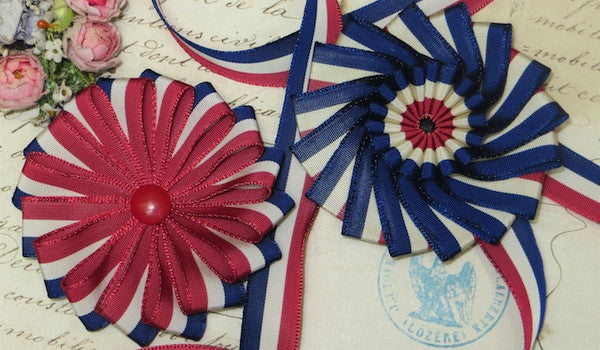
BASTILLE DAY RIBBONS
In advance of Bastille Day tomorrow, we've decided to look back at Sarah Jane Downing's insightful article on Grosgrain Ribbon from issue 61. In it, she reveals the inherent links between this versatile textile and the history of France...

Derived from the French ‘gros’ meaning large or coarse, and ‘grain’ referring to texture, the term grosgrain refers to a corded silk with a distinctive ridge that crosses the fabric. Also known as ‘grogram’ especially during the 18th and 19th centuries, the ridges in grosgrain can run vertically or horizontally depending on whether the weft or warp is chosen to be enlarged, but for ribbon it is always the weft.

First recorded in the 1580s as one of the fabrics created by the wonderfully named ‘Artisan Strangers’, grosgrain silks were a speciality of the French Huguenots who settled in England after fleeing in the wake of the St Bartholomew’s massacre. The advent of the Dutch Engine Loom in the mid 17th century allowed 12 lengths of ribbon to be woven simultaneously, no doubt fuelling fashion’s vast consumption of ribbon before the austerity of the English Civil War.

Grosgrain has a plain weave structure where multiple threads are passed across the warp alternating with single threads to give the ribbon the familiar ribs. Tightly woven, it becomes encased by the fine silk warp threads, which allows for a cheaper grade of silk or other thread to be used as the weft. In 1671 Edmund Blood patented a method for making silk waste useable, and this might well be one reason why grosgrain ribbons reached the height of fashion in the 18th century.

Grosgrain ribbons became very popular for millinery as the ribbed texture is somewhat self-supporting, allowing curls and loops to keep their shape; thus giving extra body to protect against the disintegration which can occur when silk ribbons are knotted too tightly for prolonged periods. There is also a tradition of using grosgrain ribbon for medals, and it was used to create the tricolour cockades of the French revolution. The textured design could be thought of as a forerunner to 19th century jacquard ribbons: but the threads were picked out by hand rather than the binary selection of the jacquard machine.
To order your copy of Selvedge issue 61, click here.
Images by French Kiss Ribbons.
